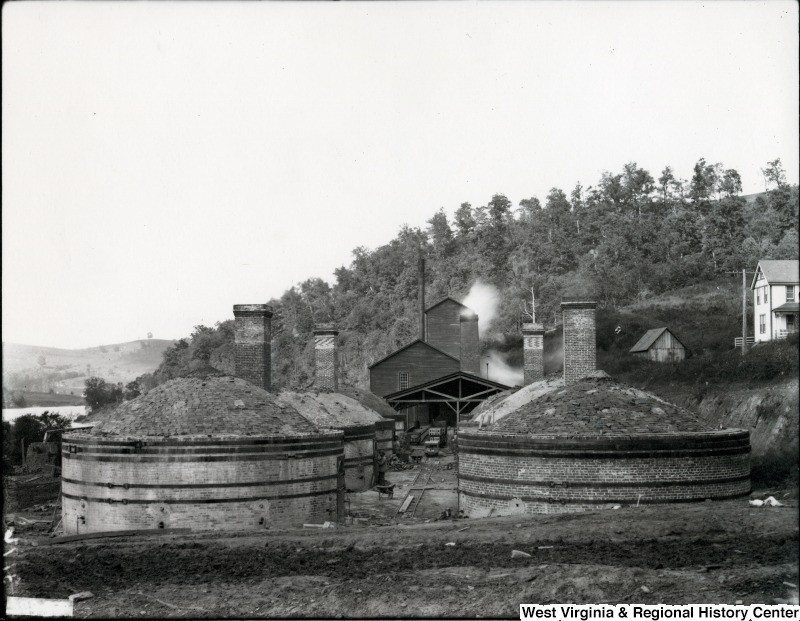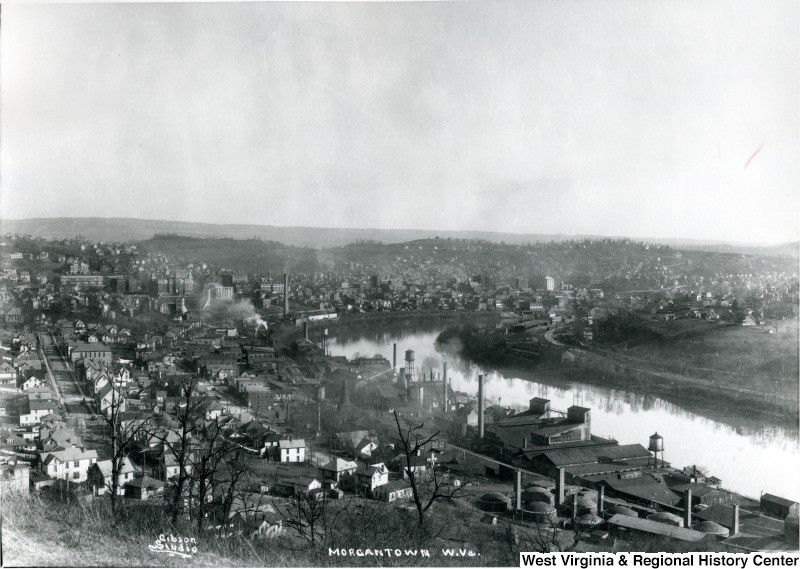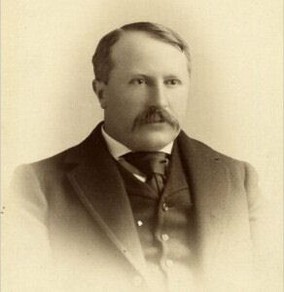Morgantown Brick Company (1899-1970s)
Introduction
Text-to-speech Audio
Images
The brickworks at Seneca could produce 28,000 bricks per day, which were fired in these six beehive-shaped kilns. Photo courtesy of West Virginia and Regional History Center, WVU Libraries.

This view of Sunnyside shows the Morgantown Brick Company's location in the bottom righthand corner. The rounded kilns were easily distinguished amongst other industries on the river, such as glass factories. West Virginia and Regional History Center

I. C. White, president of the Morgantown Brick Company. White served as assistant geologist the US Geological Survey, and surveyed PA, WV and OH and their vast mineral resources. He was appointed West Virginia's first State Geologist. Wikimedia.

Backstory and Context
Text-to-speech Audio
On the edge of the Seneca neighborhood (now Sunnyside) is the site of the former Morgantown Brick Company. While the company dates to 1890, the Seneca brickworks was the second plant of the company, constructed in 1899. The company’s first facility was in West Morgantown (Westover). Morgantown Brick Company in Seneca occupied several lots and included clay banks for mining raw material.
Thomas Benton Williams, a seasoned brick maker from Pennsylvania, recognized the increased demand for building supplies in Morgantown after the extension of the B & O Railroad. He came to Morgantown in 1889, raised stock, formed the Morgantown Brick Company, and served as its first superintendent. It is unclear how long Williams stayed on as superintendent, but it seems he took his departure before the second factory was constructed.
A group of prominent businessmen formed the Morgantown Building and Investment Company (MBIC) and bought a large section of Seneca. In addition to providing a free right of way for the B&O Railroad, the MBIC offered free land and gas to glass companies and reasonable prices for other parties.1 In 1889, Morgantown Brick purchased several lots from MBIC.2 The production of brick depends on the availability of raw material, fuel, labor and transport.3 Raw material, while usually called “clay,” is a mixture of brick earth and does not even need to contain true clay, though it is usually part of the recipe. In 1903, the West Morgantown plant made 25,000 red bricks daily; the Seneca plant made 28,000 shale bricks per day.4 Steam is the listed power and heating source, which powered the mechanics of the brick manufacturing. Once dry, the bricks were fired in kilns. Six round brick kilns – also called beehive kilns or downdraught kilns – occupied the southern portion of the Seneca property.
By 1904, the company had added a grinding room for shale, attaching it to the machine room.5 A sign of company growth may be indicated by the construction of an additional kiln. By 1921, the number of kilns increased to ten, and the steam boilers were removed as electric replaced steam.6 Production of tile at the factory began in 1925.7
The Morgantown Brick Company ceased operations sometime after 1931. Stockholders of the company unsuccessfully searched for a buyer of the brickworks after the death of its founding secretary, E.M. Grant, in 1923 and long-time president, Dr. I.C. White, in November 1927.8 In 1941, the site was sold to Edwards S. Fields.9 Fields operated a junkyard, collecting scrap iron and metal.10 In 1971, Fields and his wife, Corrine, sold the property to the WVU Board of Regents to construct the new Personal Rapid Transfer (PRT) system, a monorail that students use to travel between West Virginia University’s campuses. The PRT maintenance facilities are now located on the former site of the brickworks.
While little evidence of the company survives present day, the Morgantown Brick Company lives on in the thousands of bricks from its production that are still in use in the streets, homes, and businesses in Morgantown.
Sources
1. James Callahan, History of the Making of Morgantown West Virginia: A Type Study in Trans-Appalachia Local History (Morgantown: Morgantown Printing and Binding Company, 1926).
2. Deed of Sale, Monongalia Co., West Virginia, Book 55, p. 437. Monongalia County Clerk’s Office, Morgantown, WV.
3. R.W. Brunskill, Brick and Clay Building in Britain (New Haven: Yale University Press, 1990), 16.
4. Justin Kunkle, Editor, “Morgantown Brick Company,” Prosperity and Education Edition of the New Dominion (Morgantown: Wheeling News Litho Co., February 1903) 44.
5. Sanborn Map Company, Morgantown, Monongalia County, West Virginia: May 1904, 50ft=1inch, Fire Insurance Maps for West Virginia, West Virginia and Regional History Center.
6. Sanborn Map Company, Morgantown, Monongalia County, West Virginia: May 1921, Map 19, 50ft=1inch, Fire Insurance Maps for West Virginia, West Virginia and Regional History Center.
7. Sanborn Map Company, Morgantown, Monongalia County, West Virginia: April 1927, Map 27, 50ft=1inch, Fire Insurance Maps for West Virginia, West Virginia and Regional History Center.
8. Papers of Israel C. White Collection, A&M 710, West Virginia and Regional History Center.; Monongalia County, WV, Fiduciary Book 7, page 259, Monongalia County Courthouse, Morgantown, West Virginia.
9. Deed of Sale, Monongalia Co., West Virginia, Book 324, p. 404. Monongalia County Clerk’s Office, Morgantown, WV.
10. Morgantown City Directory (Pittsburgh: R.L. Polk and Company Publishers, 1945, 1949, 1952, 1955, 1958).
Images:
“Brick Kilns, Morgantown, W. Va.” Photo. West Virginia and Regional History Center, WVU Libraries. Accessed January 2018. http://wvhistoryonview.org/catalog/wvulibraries:9816
“Seneca Addition, Morgantown, W. Va.” Photo. 1925. West Virginia and Regional History Center, WVU Libraries. Accessed January 2018. http://wvhistoryonview.org/catalog/wvulibraries:19031
“Israel Charles White.” Photo. Circa 1898. West Virginia University Geology Department. Wikimedia Commons. https://en.wikipedia.org/wiki/Israel_C._White#/media/File:ICWhite-c1898.jpg
Research compiled by Ruthana Beezley. Edited by Elizabeth Satterfield and Pamela Curtin.
